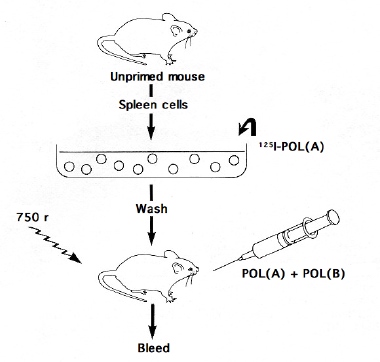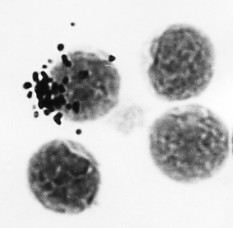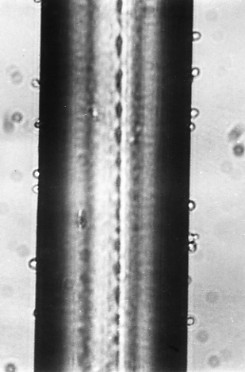Clonal Selection: Some Experiments
In 1969 the Australian immunologists Ada and Byrt reported their demonstration of
- the existence of specific antigen-binding lymphocytes prior to exposure to the antigen and
- the dependence of the subsequent antibody response on these cells.
Their test antigen was a protein, flagellin, extracted from the flagella of one strain of the bacterium Salmonella adelaide and polymerized. We shall call this antigen "POL(A)".
They made the antigen highly radioactive by labelling it with the radioactive isotope 125I.
As a control, they used a preparation of polymerized flagellin isolated from a different strain of Salmonella. We shall call this "POL(B)".
 Their Experiments:
Their Experiments:
- They mixed the radioactive POL(A) with a suspension of spleen cells from mice never before exposed to the antigen.
- After washing away any unbound antigen from the cell suspension, they used the suspension in two experiments.
1.
- They fixed the cells on a slide and coated them with a photographic emulsion assuming that if any cells had bound the antigen, the radioactivity emitted from those cells would expose the emulsion.
- By this technique of autoradiography, they showed that approximately one in 5000 spleen cells had bound the antigen.
- They also showed that binding was blocked if the cells were pretreated with an antiserum against mouse antibodies suggesting that the receptors for the antigen were cell-surface antibodies (today called the B-cell receptor for antigen or BCR).
2.
- They injected the suspension into mice whose own immune system had been destroyed by x rays.
- The activity of the 125I-labeled flagellin was so high that any cells binding the antigen would, after 16–20 hours, be killed by the radiation.
- As controls, they also injected irradiated animals with
- spleen cells that had been treated with nonradioactive POL(A) and
- spleen cells that had received no treatment.
- The three groups of animals were then injected with both POL(A) and POL(B) — nonradioactive in each case.
- While the experimental mice were able to respond to POL(B), they were unable to produce significant amounts of antibodies to POL(A). Both control groups responded to both antigens.
| Pretreatment of spleen cells |
Anti-POL(A) antibodies |
Anti-POL(B) antibodies |
| 125I-POL(A) |
± |
++++ |
| Nonradioactive POL(A) |
+++ |
++++ |
| None |
+++ |
++++ |

The image on the right supports the findings of Ada and Byrt. It is an autoradiograph of lymph node cells — taken from an unimmunized ("unprimed" or "virgin") mouse — that were treated (for 15 minutes) with radioactive POL (3H-POL). Only one of the cells has bound the antigen. Presumable the others have receptors for other antigens. The bound antigen is clustered at one pole of the cell because the cell was killed before endocytosis of the antigen-receptor complexes could be completed. Image courtesy of E. Diener from E. Diener and V. H. Paetkau, Proc. Natl. Acad. Sci. U.S.A 69:2364, 1972.

In 1972 Edelman and his colleagues at Rockefeller University demonstrated the presence of antigen-specific lymphocytes in unprimed or "virgin" mice by another method. They attached an antigen to the surface of nylon fibers and then placed the fibers in a dish containing spleen cells (mostly lymphocytes) from an unimmunized mouse. A small percentage of these cells stuck to the fibers, indicating the presence of complementary antibodylike molecules on their surface. However, no cells would stick
- if the fiber had no antigen attached to it,
- if the cells were first exposed to the same antigen in solution (thus "filling" all their receptors),
- if the cells were first exposed to antibodies against mouse antibodies (this indicating that the receptors are indeed, antibody molecules.
The image is courtesy of G. M. Edelman, from U. Rutishauser, C. F. Millette, and G. M. Edelman, Proc. Nat. Acad. Sci. U.S.A. 59:1596, 1972.
| Link to a discussion of the clonal selection theory supported by these experiments. |
10 January 2011
 Their Experiments:
Their Experiments:

